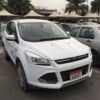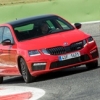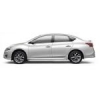Search the Community
Showing results for tags 'turbo'.
-
My Current car's COE is going to end next year, during my past around 20 years driving experience, always Manual, Sedan, NA engine, therefore my next car: 1. Must be: SUV + Turbo with decent Price 2. Better to be: Manual (it's a Dream Only) , MIJ, good FC, 3. Never consider: Sedan, Conti(Overpriced and low reliability) and Korean (roughness) brands based on above criteria, easily narrow to following: 1. Forester XT (wait for new gen launching next year) Pros: Attractive price, Powerful engine, fast acceleration, specious interior, AWD Cons: High FC, High Insurance, CVT, Burn engine oil (Hear said), Subaru Badge (ah Beng) 2. CRV-1.5T Pros: Low FC, Low road tax (1.5L only), low insurance, Honda badge(reliability), My current and past cars all Honda(loyalty discount if any), Cons: Ridiculers high price, underpowered (1.5L only), FWD only, only 2 Airbag for 5seat model, CVT, MIT, 3. Harrier 2.0T Pros: Powerful engine, fast acceleration, specious interior, Toyota Badge(reliability), DCT, Decent FC, Cons: FWD only, price High, Kindly advise Which one should I...
-
Hi All, had a friendly debate with a fellow petrol head. I was for turbo S being a super car. He was against . My argument was turbo S has 580hp and is probably the fastest accelerating car, minus the tesla. His argument was turbo S doesn't evoke the emotions like a lambo or ferrari. So my question is what make a car a supercar? Price, history, horespower, looks? what about aston, mclaren and bentley?
- 45 replies
-
- 1
-

-

Subaru WRX D.I.Y. Do it yourself everything in a day !
carloverguy2017 posted a topic in Accessories
Subaru WRX D.I.Y. Do it yourself everything in a day ! Managed to D.I.Y. connecting a car camera to a direct-wired power supply drawn from the cigarette lighter socket internally, hidden from view, and still able to have access to the stock cigarette lighter socket. Also, a cool peek on how the WRX owner D.I.Y his own STI Inter cooler mist spray ! Followed with a wire mesh wrap for his lower front bumper to prevent bugs and leaves, debris from collecting at the radiator or damaging it from pebbles and road debris. Next I have a requiem short drive in the WRX around the car park in its coil over suspension. It was comfortable actually ! Enjoy the video here. https://www.youtube.com/watch?v=U6EeFxcCfVU -
- 39 replies
-
- 5
-

-
Is this product available in Singapore? All the foreign forum users who use it are all raving about it. its been around for some time.
-
Reaching my 55k soon (done major 50k at C&C already) Thinking of leaving C&C since warranty over. Any bros here with CVT colt turbo can rec a good workshop that knows our ride well? Although I am not looking to pay peanuts but I also dun wanna kenna chop like by C&C. Just a good honest workshop who knows the CVT Colt Turbo well. Cheers
- 17 replies
-
About 2 decades ago, the term bread and butter car model used to be refering to car with engine capacity of 1.0L or lesser, and mid size family sedan are the Corolla, Sunny, Mazda 323, Civic, Jetta and such. Sub 1.0L rides make up some 12 - 15% of our passenger car population, and proved to be popular for those looking at a simple point A to point B personal transport tool. Some of the hot model include: Suzuki Swift Sedan Suzuki Wagon R Toyota Starlet Nissan March Subaru Justy Subaru Vivio Daihatsu Charade Daihatsu Move Mitsubishi Toppo Town Bee Mitsubishi Pajero Mini Fiat Uno Seat Ibiza Sales of sub 1.0L rides start to fall by the end of 90s / early 2000, due to the ever rising COE premium (and no thanks to the merger of Cat 1 & 2 COE into Cat A in May 1999), as well as the better acceptance of Korean model (Accent, Getz, Atos, Rio, etc.). IIRC, the last 1.0L (non-turbo) model sold in Singapore is the Hyundai Atos, which at it lowest price point, can be had for <S$30K. T.B.C.
- 119 replies
-
- 12
-

-
S$99,999 promo for 1.4T Chevrolet Cruze Turbo at causeway point! normal plate! Pricing very attractive for 1.4 turbo charged cruze, original price $109,999. Now $99,999 !! Any comments???
- 9 replies
-
- chevrolet
- chevroletcruze
- (and 7 more)
-
http://paultan.org/2011/12/22/driven-proto...st-impressions/ A turbocharged MPV!!! I feel like ripping out the engine and drop it into my Neo. Proton also drop the VVL and change it to VVT for the intake (I think it is to improve FC).
-
Wonder will BM bring this babe to SG? http://www.autoguide.com/auto-news/2015/08/lexus-gs200t-joins-gs-lineup-refresh.html The major announcement is the addition of the GS200t to the lineup, sporting a 2.0-liter turbocharged four-cylinder engine with 241 hp and 258 lb-ft of torque. The powerplant is mated to an eight-speed automatic transmission........
- 17 replies
-
- 2
-

-
- lexus
- lexuslexus
-
(and 2 more)
Tagged with:
-
Dear Forummers Can anyone teach/show me how to dismantle this burner so that I can get a replacement....as can see from the pic..the rim is warp...Thank you in advance
- 44 replies
-
- lite n live
- general
- (and 4 more)
-
140HP same look what a waste anyone know the price the design is a turn off
-
Nissan brought in the Slyphy SSS which spots a 1.6 turbo engine with 190ps and 240nm. Due to the weight it's not really a sprinter but produced a decent 8.4sec century sprint. Anyone interested? I would if the SSS looked like this: EXPECTATION Instead of this: REALITY But still I might give it a test drive. Who knows it might be a nice drive.
- 185 replies
-
- 3
-

-
- nissan
- nissan slyphy
- (and 4 more)
-
just wondering if anyone is driving the abovementioned car and can give a review on it?
-
If you have not heard of this German brand, you are not alone. But if you make a quick search on the web, once Germany's third-largest car maker, does have some iconic model half a decade back. The German car maker unveiled its first model for 54 years, the BX7 SUV, at the recent Frankfurt Auto Show. The company, which is based in Stuttgart and backed by Chinese commercial-vehicle manufacturer, Beiqi Foton, tragets sales of more than 500,000nautos in the "medium terms", COE Ulrich Walker said in an interview. The company plans to launch sales with the midsize SUV, before adding 2 smaller SUVs, a sedan and a van.
-
Was toying with the idea of purchasing one 2nd hand. For Renault die hards, what are the common issues? Is servicing at Wearnes a bitch and cost an arm and a leg?
-
I know this is a weird topic but I really just wanna reach out to people who have this engine so as to share info. Please feel free to comment if you are knowledgeable on this topic. I am starting this topic for the MR16DDT engine, known as the 1.6 DIG-T engine in Nissan cars. It is a turbo charged direct injection 1618cc engine. So far, in local context I only know 3 car models use it. Please share if you know more. - Renault Clio RS (200HP, 240nm?) - Nissan Juke Turbo (187HP, 240nm) - Nissan Sylphy SSS (187HP, 240nm) I am driving a SSS. The Sylphy threads are very inactive and there does not seem to be any fellow SSS drivers around. I am going for 10k servicing soon. Had been using Tan Chong's mineral oil at 1k, 5k servicing and wanna use syn oil for next servicing as engine should have break-in now and starting on 10k intervals next. Tan Chong has their own in-house brand syn oil. I am thinking of bringing my own oil but not sure which type to use. Can anyone share what oil they had used for this engine? Should i get xW30 or xW40 oil? I don't go to the tracks at all.
- 13 replies
-
- 1
-

-
Ha! NSP chut the xmm card again! I am getting my popcorn ready! Hope have straight up 1v1 fight but I wonder if PAP will allow.
-
To those driving the small cc models with turbo like Ford's Ecoboost or VW's TSI, do you agree with their report? http://pressroom.consumerreports.org/press...my-entry-2.html
-
Hi just want to know from old birds and ppl who change cars often . My car coe ending soon so .... checking 😊 Is it worth buying and then extending coe of use turbo cars like EVO ,WRX,Forester & airtrek ? Thanks
- 12 replies
-
- turbo cars
- evo
- (and 7 more)
-
http://www.youtube.com/watch?v=XAId3vqwqvc The Nissan GTR is commonly known as the 'King of drag race' with its potent off-the-line performance. Credits to its clever all-wheel drive system, the GTR can effectively put down its 545bhp and 630Nm of torque on the drag strip. Recently, however, British publication EVO took out the GTR and pit it against Porsche's new 911 Turbo - and found otherwise. In comparison, the 991 gen Turbo has 520 horses - 25 fewer than the GTR. But it weighs 1,665kg - compared to the GTR's 1,746kg. That could have given it a slight advantage.
-
For internal combustion to take place, fuel needs oxygen, the source of which is atmospheric air. During the intake stroke (as the piston descends within the cylinder), the mass of air inducted is strictly at ambient pressure. Cylinder volume is a physical constant, but the mass of air that fills any space is a function of pressure. Hence, the higher the pressure, the greater the mass of air that can occupy any given volume, simply because air is compressible. A device that “blows” air into the cylinder would enable more air-mass to be squeezed inside said cylinder than by natural aspiration alone. This concept of forcing air into the cylinder to achieve greater than 100 per cent volumetric efficiency at a given ambient pressure is termed “supercharging”. The device mentioned in the previous paragraph is called a compressor. It can be driven by an electric motor, or mechanically by a belt off the crankshaft. The turbocharger, however, relies neither on a motor nor a belt. Instead, a turbo compressor is driven by a shaft-connected turbine, which is made to spin by the hot, fast-fl owing exhaust gases of combustion. In theory, then, turbo-supercharging (to use the “correct” technical term) consumes no energy on its own since exhaust gases are waste products of the internal combustion process. HOT AND BOTHERED Turbocharging, though highly effective, isn’t as simple as it sounds. Heat is turbocharging’s biggest complication. Compressed air, especially if it flows from an exhaust gas-driven device, experiences a significant rise in temperature. Not only does this mean a drop in the density of said air, it also causes pre-ignition of the air-fuel mixture in the combustion chamber – a phenomenon that frequently leads to stress failure in the cylinder head (and sometimes even the engine block). It was essentially for this reason that the grand-daddies of turbo engines were designed with ridiculously low compression ratios – 6.5 to 1 in the case of Porsche’s 930 Turbo. This alleviated the pre-ignition problems, but the downside was lethargic pre-boost performance, better known as turbo lag. The turbo motor would be relatively lethargic till about 3000rpm, but the surge that came thereafter more than made up for lost time. Porsche later incorporated something called an intercooler into the 930’s engine plumbing. It is basically a heat exchanger, which works like a radiator to cool the compressed air as it flows into the intake manifold. This allows the engine to run a slightly higher compression ratio and increases the density of intake air. THE TURBO TODAY While performance continues to be a major incentive to force-feed engines using a turbocharger, tremendous progress in the capabilities of both hardware and software has realised huge gains in fuel consumption and exhaust emissions, too. Arguably the greatest effect the turbo has had on the automotive industry is “downsizing”, or the reduction of engine cubic capacity. Volkswagen’s 1.4-litre TSI engine is a perfect example of the modern, small capacity turbocharged engine. There’s no turbo lag or overheating, just plenty of smooth torquey performance that belies the quoted 122bhp, thanks to a full 200Nm of torque available between 1500rpm and 4000rpm. The 1.4L VW’s sprightly mid-range acceleration feels more like that of a 2-litre, but when it comes to average mileage, the figures are closer to those of a naturally aspirated 1.2-litre. It’s the proverbial best of both worlds, on wheels THE TURBO TOMORROW Today’s state-of-the-art turbo engines deliver performance, economy and driveability that their naturally aspirated cousins of a similar capacity cannot match. With turbo technology continuing to improve, future turbocharged engines are likely to be even better than the ones we have right now. This article was written by Shreejit Changaroth, freelance writer for Torque.
-
- turbo
- turbocharging
-
(and 2 more)
Tagged with:
-
Proton Suprima S! Looks good from the pictures. I think that proton designs are getting better. Will we see it in Singapore? Hope it handles better than the Savvy http://paultan.org/2013/08/28/driven-proton-suprima-s-review/
-
Just to check does anyone has any idea when Defi oil pressure dip down and show red alarm during idling? It will dip up and down, sometime it will just hold on.
- 11 replies
-
- mitsubishi
- turbo
-
(and 2 more)
Tagged with:
-
Plan either buy used Jetta sport or Mit Lancer 1.8 Turbo. Which is better? I heard from VW forum, thousand of ppl complain abt DSG gearbox. any advise?











